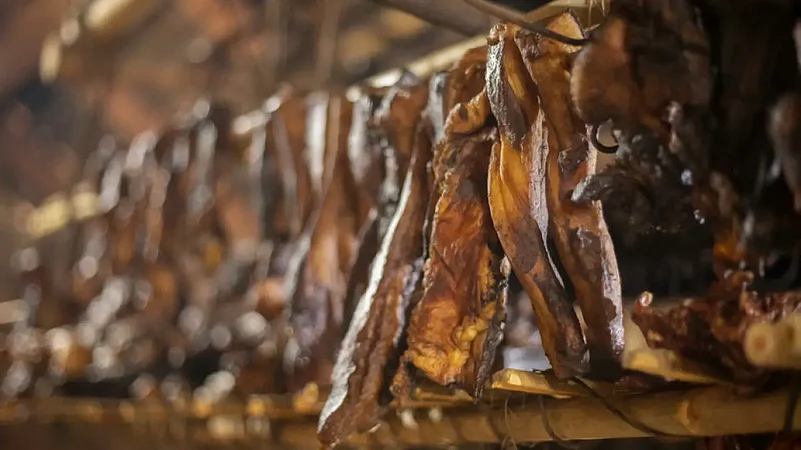Food is a site for sustenance, nourishment and well-being for human existence in mainstream societies. In parallel to these, a distinct worldview exists among indigenous peoples. Drawing from their worldview, food is something that encompasses their way of life. In food, they conduct ceremonies for all walks of life--from birth to funeral, interface with spirits and gods, and social bonding. These features endow food with a significant place in their life. They gain nourishment from food for their existence and foster their relationship with land, spirits and ancestors. Based on the significance of food to their lives, they predicate their socio-cultural identity on food. This notion reflects on how indigenous peoples define food sovereignty as a way of maintaining culturally adapted indigenous foods.
Dog meat ban and Naga tribes
Among the Nagas, spread across Nagaland, Manipur, Assam, Arunachal Pradesh and Myanmar, food holds a significant place in their worldview. The politicisation of their food practice was uttered in the Naga Club’s memorandum to the Simon Commission in 1929, “…Our language is quite different from those of the plains and we have no social affinities with the Hindus or Muhammadans. That we are looked down upon by the one for "beef" and the other for our "pork" and by both for our want in education, is not due to any fault of ours.” Through this memorandum, they demonstrated the distinctiveness of their identity, using food and language to make their call for sovereignty.

Ninety-one years later, the politicisation of food in the name of animal activism took place against dog meat consumption among the Nagas. Mobilisation and momentum among animal activists for a call to ban dog meat in Nagaland galvanised into coercing the Nagaland state government to ban dog meat on July 3, 2020. The move from animal activists was spearheaded by various organisations like People for Animals (PFA). Their activism was heralded as a success for animal rights while overtly playing into existing racist caricatures against the Naga tribes. The message from PFA conveys that consumption of dog meat in Naga societies is “illegal according to the laws of India.” This reference must examine along with the existing Article 371A of Nagaland- a provision that allows the Nagas to uphold their customary law and social practices.
The dog meat ban caused an uproar among the Nagas, civil societies and alike. Eventually, the ban was stayed by the Kohima bench of the Gauhati High Court in late November 2020 . However, the incident raised many questions as to why there is an unequal power relation between mainstream and Naga societies when it comes to food. The politics around food suggests that it is rooted in stereotypes and racism against the Naga people. In this lacuna, it will be proper to look into the politics and framework of food discourse in India and what dog means to Naga tribes.
Food debate and discourse
For the last decade, the ongoing debate around food in India is heavily weighted towards beef and its consumption. The scholarship around the food debate implies that caste and class play important roles in dictating and normalising what counts as food. When the beef debate came to academia and public forum, and at the policy level, it rested on factors like livelihood of minorities, beef as a source of proteins and nourishment, upholding religious sentiment of neighbouring communities, and so on. How tribal people integrate meat, including beef, pork, dog, cat etc., into their culture, custom, and ceremonies are passed off with obscurity or, at best, under footnotes.
As such, discourse emanating from the food debate anchors heavily on dominant cultures disregarding the cultures and lifeworld of indigenous tribal communities. To this, one must look into what framework defines food discourse in India regarding indigenous tribal communities in general, and Nagas in particular. Irrespective of the background of people in any place beyond the northeast region of India, racism and cultural chauvinism come into play when it comes to the food practices of Naga tribes. The degree of outrage in response to the beef ban was widespread across all the spectrums of mainstream societies: young or old, liberals or left, and the rest. Its energy fell flat when it came to the dog meat ban in Nagaland. Rather, it unites the beef advocateurs and animal activists in subjecting and seeing the Nagas as uncivilised, barbarous, and unsympathetic. The food practice and its cultural aspect residing among the Nagas is a far cry for its acknowledgement and meaningful engagement.
In the writing of Naga anthropologist Dolly Kikon on akhuni, she brings forth how akhuni--a fermented soyabean paste--when eaten in places like New Delhi, causes conflict. The point here is that, the denial of the existence of unique food practices among the Nagas is not restricted to dog meat, and it is extended very well into how they are looked down upon for cooking bamboo shoots, fermented soyabean (khui/akhuni), fermented fish (ngari) etc. across India outside the Northeast. Moreover, representative recipes of Nagas fail to make it to the menus even in the most liberal university in India, or canteens and cafes, barring select restaurants in metros.
What dogs and their meat mean to the Nagas
To the food discourse, it is pertinent to subtract the moral strand and approach consumption of dogs, pork, beef, cat, fish, chicken etc, with openness to culture and choices people make across the world. The consumerism factor affects all of us, but that does not mean being dismissive of food practices of communities that are distinctive to one’s existing notion of food. On this ground, delving into the Naga’s integration of dogs in their lifeworld and as food, a revisit to accounts written by colonial anthropologists and officers, and existing legends and oral stories are required.
In the existing accounts written by anthropologists and colonial officers, the Ao, Angami, Rengma, Sema, Lotha and various Naga tribes are being written as depending on the dog as one of the many animals for a source of meat. To the Angami Naga, dog meat consumption is considered auspicious on a particular genna (a socio-religious practice) as they believed in extracting medical value in the dog meat. Additionally, it averted illness for the coming year. In the case of the Rengma Naga v, more male dogs were eaten before their potential to breed was contained. All these accounts reflect how intrinsic dog meat occupies in the plate of Naga tribes from the past.
Dogs are reared for multiple purposes besides relying on dog meat for food. Existing written accounts note that dogs were reared for hunting purposes where dogs provided companionship and assistance. The Nagas were written to be relying on dogs during hunting to chase the prey in the account of TC Hodson . When dogs reared for hunting die, the owners often pass them to others for their consumption as they hold an emotional attachment to dogs. A similar notion is upheld among the Sema Naga as they revere hunting dogs over ordinary dogs. Among the Angami Naga, hunting dogs, when they grow old and stop taking part in hunting, are given to others for consumption.
Rearing of dog among the Nagas serves various purposes. One of them is that the howling of dog at night is perceived as the presence of evil spirits around and ritual is usually performed. The role of dogs is also present in the legends and folk stories of Naga tribes. Among the Rongmei Naga. they have a ritual practice involving dog. The ritual is performed when someone dies wherein animals like dogs are sacrificed to help the departed soul reach the land of dead. The Lotha Naga and the Sema Naga are also written as having similar practices regarding the land of dead. After the advent of Christianity, and conversion to Christianity, most of these ritual practices were stopped. But the consumption of dog meat continues.
Contemporary politics and the way forward
Despite the onslaught of colonialism, Christianity and changes in Naga tribes, the culture attached to their food finds continuity from the past to the present. In food, the Nagas derive their past, cultures, and knowledge. The significance food plays is inherent in their identity. The existing ethnographic accounts hold that food and dog meat are a site for linkage between the past and present and how they maintain continuity of their lifeworld from their ancestors’ period.
As the Naga society is still recovering and grappling with racism, AFSPA, and a violent past, dog meat and its cultural values help them sustain their identity. The ban on dog meat is seen not only as an assault on their cultural identity but also as treating the Nagas as inhuman, uncivilised, and barbaric. The move by animal activists and apathetic outlook from mainstream societies at the Nagas, are no different from colonial forces to the AFSPA and racism at play. As they all converged on the idea of assimilating and disciplining Nagas to accept worldview different from theirs. Acknowledging differences and their expressions in food practices is a path towards maintaining and securing the rights and lifeworld of Naga tribes.
(Richard Kamei is Lecturer of Anthropology at Royal Thimphu College, Bhutan)





















